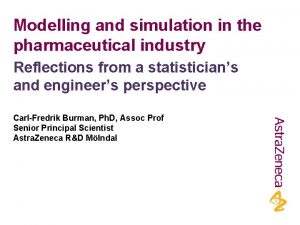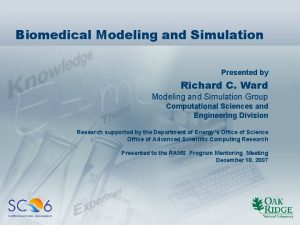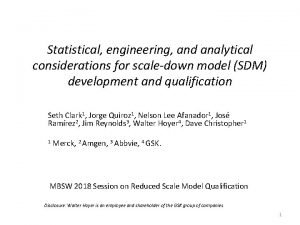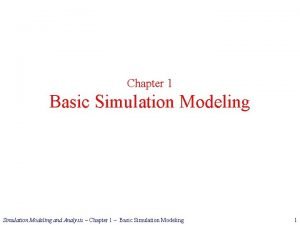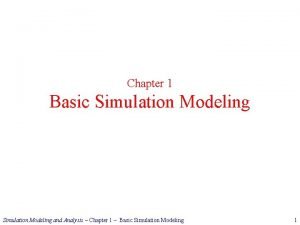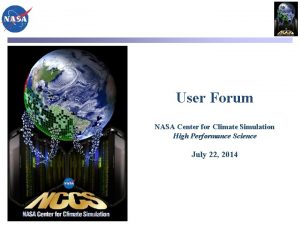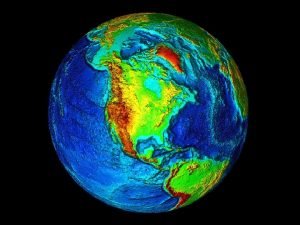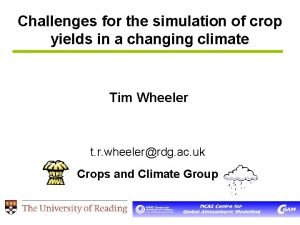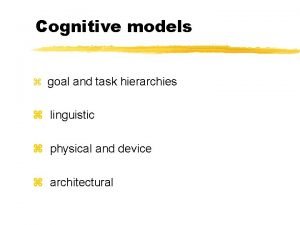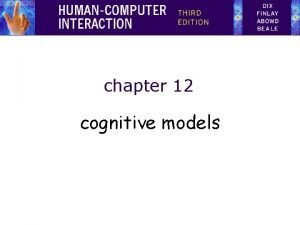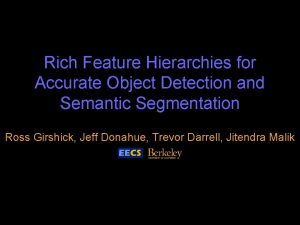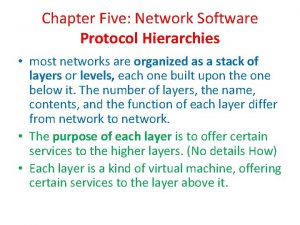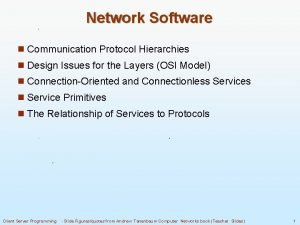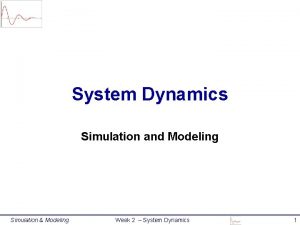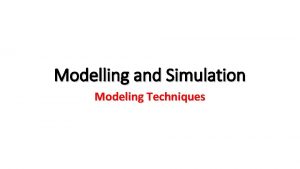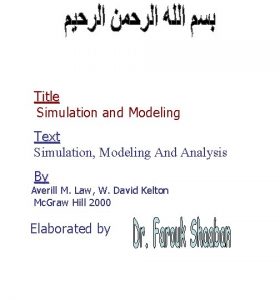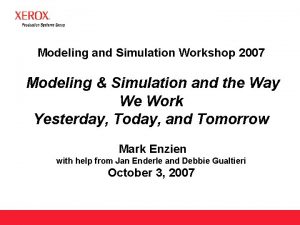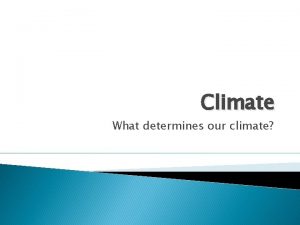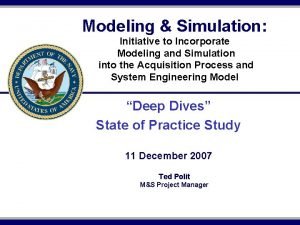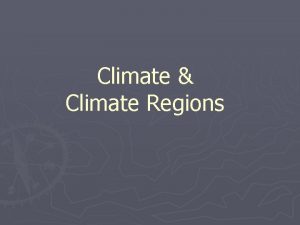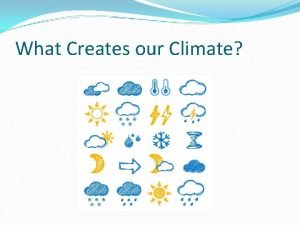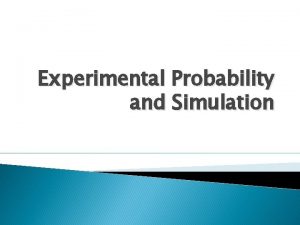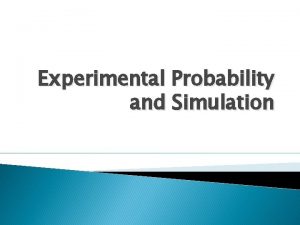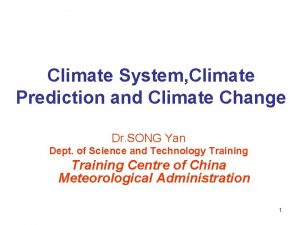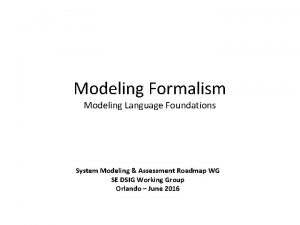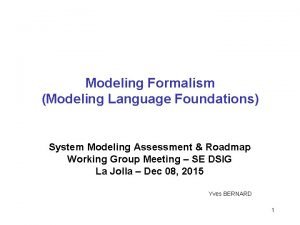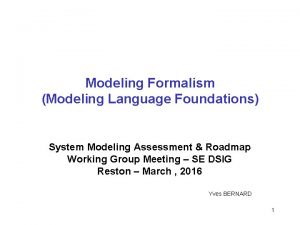Simulation and Modeling Hierarchies of our Climate System



































- Slides: 35

‘Simulation and Modeling Hierarchies of our Climate System’ A. Pier Siebesma KNMI & TU Delft The Netherlands 7 oktober 2009 Delft University of Technology Challenge the future

Uncertainties in Future Climate model Predictions IPCC 2007 1900 Past Present 2. 5 -4. 3°C Future Simulation and modeling hierarchies 2

Earth’s Global Energy Balance 342 W/m 2 Incoming solar radiation 235 W/m 2 107 W/m 2 Outgoing long wave radiation Temperature Reflected solar radiation Verstoorde wolken in een opwarmend klimaat 3

Increase of Greenhouse Gases……. 342 W/m 2 Incoming solar radiation …. . decrease in outgoing long wave radiation 107 W/m 2 …. increase of temperature Reflected solar radiation Verstoorde wolken in een opwarmend klimaat 4

……restored new Equilibrium 342 W/m 2 Incoming solar radiation 235 W/m 2 107 W/m 2 Outgoing long wave radiation Higher equilibrium temperature Reflected solar radiation Verstoorde wolken in een opwarmend klimaat 5

If climate would be static………… Top of the atmosphere : Planetary Albedo R: net radiation at the TOA External Perturbation Zero feedback gain Verstoorde wolken in een opwarmend klimaat 6

If climate would be static………… Top of the atmosphere : Planetary Albedo R: net radiation at the TOA Planck Parameter Forcing for 2 XCO 2 External Perturbation Zero feedback gain Direct Warming Verstoorde wolken in een opwarmend klimaat 7

Dynamical Climate Model Feedbacks perturbation zero feedback gain feedback processes Verstoorde wolken in een opwarmend klimaat 8

2 XCO 2 Scenario for 12 Climate Models Cloud feedback Surface albedo feedback Water vapor feedback Radiative effects only Dufresne & Bony, Journal of Climate 2008 Cloud effects “remain the largest source of uncertainty” in model based estimates of climate sensitivity IPCC 2007 Verstoorde wolken in een opwarmend klimaat 9

Primarily due to marine low clouds Stratocumulus Shallow cumulus “Marine boundary layer clouds are at the heart of tropical cloud feedback uncertainties in climate models” (du. Fresne&Bony 2005 GRL) Verstoorde wolken in een opwarmend klimaat 10

1. The planetary scale Cloud cluster scale How did I get here? ~107 m Cloud microphysical scale ~10 -6 m - 1 m ~105 m Cloud scale ~103 m Verstoorde wolken in een opwarmend klimaat 11

No single model can encompass all relevant processes mm 100 m 1 km Cloud microphysics turbulence Cumulus clouds DNS 10 km 1000 km Cumulonimbus Mesoscale Extratropical clouds Convective systems Cyclones 10000 km Planetary waves Large Eddy Simulation (LES) Model Cloud System Resolving Model (CSRM) Numerical Weather Prediction (NWP) Model Global Climate Model

Schematic View of how scales are connected in traditional GCM’s turbulence convection Resolved clouds Scales radiation ~ 100 km Small scales Large scales Depiction of the interaction between resolved and parameterized unresolved cloud-related processes (convection, turbulence, clouds and radiation) in present-day climate models. (from Siebesma et al, Perturbed Clouds in our climate system MIT) Which are the problems, errors and uncertainties that we have to face with this approach?

1. Inherent lack of understanding of certain physical processes < 100 mm [100, 600 mm] >800 mm Uncertainties in ice and mixed phase microphysics: • Supersaturation • Liquid vs ice • Habits • Size distribution • Sedimentation • Interaction with radiation No fundamental equations available describing these properties and processes. Source : Andrew Heymsfield

2. Non-linear character of many cloud related processes Example 1: Autoconversion of cloud water to precipitation in warm clouds : Kessler Autoconversion Rate (Kessler 1969) With: ql : cloud liquid water ql : critical threshold H : Heaviside function A : Autoconversion rate ql=1 g/kg GCM grid box ql=0 Autoconversion rate is a convex function: Subgrid variability of liquid water needs to be known in order to estimate the autoconversion………. Larson et al. JAS 2001

Example 2: Cloud fraction and Cloud liquid water qsat qt qsat(T) Cloud fraction: . Cloud liquid water: (T, qt) qt Subgrid variability of temperature and humidity needs to be known in order to estimate the grid box cloud fraction ac and liquid water content ql T

Example 3: Cloud Albedo Bias Scu Cloud albedo Plane parallel cloud a x x Liquid water path (LWP) a(LWP) < a(LWP) Neglecting Cloud inhomogeneity causes a positive bias in the cloud albedo.

• These biased errors slowly go away when increasing model resolution: • Typically allowed if x < 100 m • So for all models operating at a coarser resolution additional information about the underlying Probability Density Function (pdf) is required of temperature, humidity (and vertical velocity). For Example: So if only…. . we would know the pdf.

3. Interactions between the various subgrid processes turbulence convection Resolved clouds Scales radiation ~ 250 km Small scales Large scales • Subgrid processes strongly interact with each other while in (most) GCM’s they only interact indirectly through the mean state leading to inconsistencies and biases.

4. Statistical versus Stochastic Convection • Traditionally (convection) parameterizations are deterministic: • Instantaneous grid-scale flow and mean state is taken as input and convective response is deterministic • One to one correspondency between sub-grid state and resolved state assumed. • Conceptually assumes that spatial average is a good proxy for the ensemble mean. ~500 km e. g. subgrid cloud fraction :

4. Statistical versus Stochastic Convection Statistical ensemble mean That takes into account fluctuations so that the ensemble mean is not satisfied each timestep but more in a canonical sense Deterministic convection parameterization Microcanonical limit Explicitly resolved 100 m 1 km 100 km resolution 1000 km

New Pathways

Pathway 1: Global Cloud Resolving Modelling (Brute Force) turbulence Resolved convection Scales clouds radiation 3. 5 km NICAM simulation: MJO DEC 2006 Experiment 3. 5 km run: 7 days from 25 Dec 2006 • Short timeslices • Testbed for interactions: deep convection and the large scale • Boundary clouds, turbulence, radiation still unresolved MTSAT-1 R NICAM 3. 5 km Miura et al. (2007, Science)

Pathway 2: Superparameterization (b) turbulence 2 D convection Resolved CRM clouds Scales radiation 5 km 250 km

Pathway 2: Superparameterization What do we get? • Explicit deep convection • Explicit fractional cloudiness • Explicit cloud overlap and possible 3 d cloud effects • Convectively generated gravity waves But…. . A GCM using a super-parameterization is 2 to 3 orders of magnitude more expensive than a GCM that uses conventional parameterizations. On the other hand super-parameterizations provide a way to utilize more processors for a given GCM resolution Boundary Layer Clouds, Microphysics and Turbulence still needs to be parameterized

Pathway 3: Consistent based parameterizations Remarks: turbulence Resolved Scales convection Resolved clouds Scales radiation Unresolved scales ~100 km Large scales Increase consistency between the parameterizations! How? Topic of the coming week.

Use the full range of observations and simulation hierarchy. . GEWEX Cloud Systems Study (GCSS) Strategy. Direct Numerical Simulation Large Eddy Simulation Instrumented Sites Single Column Models Field Campaigns Climate Models NWP Models Global Observational Data sets

Direct Large Global Numerical Eddy Climate Simulations Laboratory experiments Atmospheric Field Profiling campaigns stations High resolution Scale Hierarchy Satellite Simulations Observations data Low

Example: Bulk Model (“parameterization”) of Scu topped PBL Minimal Mixed layer Model qt ql we qt, i we ql, i zi V qt, 0 V ql, 0 Plus closure:

high Level of microphysical Mixed layer models “understanding” Models/Parameterizations or conceptualisation Direct Large Global Numerical Eddy Climate Simulations low Laboratory experiments Atmospheric Field Profiling campaigns stations High resolution Scale Hierarchy Satellite Simulations Observations data Low

high Conceptual models Statistical Mechanics Self-Organised Criticality Level of Interface & Mixed layer “understanding” microphysical models Models/Parameterizations models or conceptualisation Direct Large Global Numerical Eddy Climate Simulations low Laboratory experiments Atmospheric Field Profiling campaigns stations High resolution Scale Hierarchy Satellite Simulations Observations data Low

Complexity P. W. Anderson Dielectric Breakdown “More is Different”, Science 1977 “the emerge of collective properties with a large number of interacting elements” Interacting elements: Galaxy distribution • Atoms in Physics • Macromolecules in Biology • People in economics • Convective cloud elements in atmospheric Science? Internet structure

Phase Transitions in Statistical Mechanics Toy Example: Percolation p=probability of having a conductive bond 1 -p = probability of having a insulating bond p=0. 3 insulating pc=0. 5 Transition point p=0. 8 conducting At the transistion point: scaling laws, fractal geometry, renormalization group theory But……This exotic behaviour is only achieved if the order parameter (p) is exactly set to the critical point.

Self Organized Criticality • In many non-equilibrium systems self-similarity and fractal behaviour emerges spontaneously (including atmosperic turbulence, convection and clouds) • Toy model that displays this features: Sand Pile Model. Add randomly grains of sand: Redistribute grains if a local threshold slope is reached: Causing avalanches of any scale (power law).

high Conceptual models Statistical Mechanics Self-Organised Criticality Level of Interface & Mixed layer “understanding” microphysical models Models/Parameterizations models or conceptualisation Direct Large Global Numerical Eddy Climate Simulations low Laboratory experiments Atmospheric Field Profiling campaigns stations High resolution Scale Hierarchy Satellite Simulations Observations data Low
 Helen erickson nursing theory
Helen erickson nursing theory Simulation modeling and analysis law kelton
Simulation modeling and analysis law kelton Pharmaceutical simulation and modeling
Pharmaceutical simulation and modeling Introduction to modeling and simulation
Introduction to modeling and simulation Biomedical modeling and simulation
Biomedical modeling and simulation Pengertian pemodelan dan simulasi
Pengertian pemodelan dan simulasi Site:slidetodoc.com
Site:slidetodoc.com Dimensional modeling vs relational modeling
Dimensional modeling vs relational modeling Basic simulation modeling
Basic simulation modeling Basic simulation modeling
Basic simulation modeling Nasa center for climate simulation
Nasa center for climate simulation Climate simulation
Climate simulation Climate simulation
Climate simulation Climate change 2014 mitigation of climate change
Climate change 2014 mitigation of climate change Goal and task hierarchy model
Goal and task hierarchy model Issues for goal hierarchies
Issues for goal hierarchies Rich feature hierarchies for accurate object detection
Rich feature hierarchies for accurate object detection Deep processing ap psychology definition
Deep processing ap psychology definition Network software protocol hierarchies
Network software protocol hierarchies Preying mantra wangechi mutu
Preying mantra wangechi mutu Protocol hierarchies
Protocol hierarchies How is climate change affecting health
How is climate change affecting health Our awareness of ourselves and our environment
Our awareness of ourselves and our environment Our awareness of ourselves and our environment
Our awareness of ourselves and our environment Our awareness of ourselves and our environment
Our awareness of ourselves and our environment Our awareness of ourselves and our environment is called
Our awareness of ourselves and our environment is called What is process modeling in system analysis and design
What is process modeling in system analysis and design System requirements checklist output example
System requirements checklist output example Thinking affects our language, which then affects our:
Thinking affects our language, which then affects our: Our census our future
Our census our future Christ be our light
Christ be our light Our life is what our thoughts make it
Our life is what our thoughts make it We bow our hearts we bend our knees
We bow our hearts we bend our knees Our census our future
Our census our future Our life is what our thoughts make it
Our life is what our thoughts make it Money madness meaning
Money madness meaning


